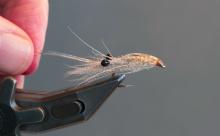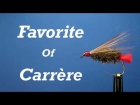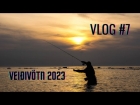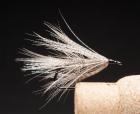One Mallard Shrimp
As a Baltic sea trout angler you can never get enough shrimp patterns, and this one was tied as a result of access to some really fine mallard feathers.
We had been fishing for a few spring days in the southern part of Denmark, and not caught much, but had some fun and some small fish.
Paul, a German/American friend, kept one, nice, bright sea trout, and when he gutted it, he found two large, almost undigested shrimp in its stomach.
No big surprise there, because we had seen the shrimp in the fairly cold spring water and it's also a fact that the Danish sea trout have shrimp high on their menu - if not on top - especially in the spring where many other food sources are scarce.
In the type of fjord where we were fishing, the shrimp are some of the first animals to start buzzing around in the shallow water as soon as the sun starts heating it up just a bit.
So a shrimp fly or several should always be in the flybox of an angler who is seeking the spring sea trout in the Baltic.
Other people can fish pink and paintbrushes. To each his own.
Large and colorful shrimp patterns
A pink paintbrush, yes, but a shrimp, no!
No doubt they can catch fish and have done so many, many times, but it's nothing that I find attractive even though the fish might. I prefer my shrimp smaller, grayish and a little more discrete and looking like the natural.
Other people can fish pink and paintbrushes. To each his own.
I had already been fooling around with mallard feathers on that same trip. Paul had actually brought a whole bag full of nice, large and regular feathers from mallard and gadwall, and I thought that one such feather ought to be able to produce a shrimp. The light barred barbs are fine for antennae, mouth parts, legs and the plumulaceous part at the base is excellent for dubbing. I added some Easy Shrimp Eyes and a bit of flash plus some LCR to make a shell, and the recipe for a nice shrimp was there.
This fly wound up so simple that it ought to be called Martin's Mundane Mallard Shrimp in accordance with the Mundane Manifesto. But it ended as the One Mallard Shrimp, but still only uses three materials. The hook is a Kamasan B175, so exchange the thread for black and you are almost there. The store bought eyes are special and might be hard to get, but simple, cheap, home made mono eyes can easily do the trick.
From one feather you will get barbs for the shrimp's thorn, the fluffy part will make some excellent dubbing for the body and the remaining barbs can be wound as a hackle that will form shell and legs.You can use mallard, teal, gadwall or any other finely barred feather with the same long, fine barbs and a fluffy, downy part to provide dubbing.
The fly is really easy to tie, and the only advanced step is using Light Curing Resin for the shell, and even that is easy.
Shrimp flies are supposed to fish fairly deep, and over water depths in the 1-2 meter range or some 3-6 feet deep it should actually be on the bottom or at least close. That might call for a bit of weight, and adding some heavy wire under the body can be necessary unless you want to wait for the fly to sink or use an intermediate or sinking leader.
Shrimp are usually slow moving animals that hover gently over the bottom, rocks or sea weed, but once they are disturbed, they shoot off in a blitz fast jerk. You can partly mimic that with a steady and slow retrieve broken by some sudden, short pulls in the fly line.
You can tie the fly with the barred feathers from any of these birds. The One Gadwall Shrimp, The One Mallard Shrimp and the One Teal Shrimp. I don't think the fish will care.
I don't think the fish will care.
Read more about why you should register.
More content from the front page
Since you got this far …
… I have a small favor to ask.
Long story short
Support the Global FlyFisher through several different channels, including PayPal.
Long story longer
The Global FlyFisher has been online since the mid-90's and has been free to access for everybody since day one – and will stay free for as long as I run it.
But that doesn't mean that it's free to run.
It costs money to drive a large site like this.
See more details about what you can do to help in this blog post.






























































































Comments
Wow..! this is the best
Wow..! this is the best simple schrimpfly i have seen in years..easy to tie and looks good, i have already added a dusin to my flybox.beside fishing, hunting is also my sport so the feathers come in plenty.
thanks for sharing.
tight lines and best regards.
michael.
Sleek and functional
Sleek and functional. Achille Castiglioni would have not designed it better, had this pattern been an avant-garde furniture piece.
BTW, this is by far the best site for patterns and fly fishing in general.
Bruce, You had me
Bruce,
You had me laughing there!
I'm both glad and sorry that the flies were so realistic that the birds took them. Imagine their effect when fish are around!
You will have to tie up a new bunch and keep a good eye on them while they cure.
Martin
Made three of these
Made three of these and put them out in the sun to finish curing. They promptly disappeared. I think they have been so buggy looking that the birds carried them away!
G'day Martin... 'Re
G'day Martin...
'Rephreshing as ALWAYS and bordering on BRILLIANT...
Your shrimp cocktail goes nicely with Riesling...
petegray
Kate, I also alwa
Kate,
I also always had a weak spot for the term plumulaceous. I learned it while studying biology and was reintroduced to it by Wayne Luallen in his feather anatomy article.
A great word, but impossible to remember and pronounce unless you really concentrate. I usually just say webby...
Martin
Martin, With, or wi
Martin,
With, or without the help of Talisker, you certainly do have the inspiration to tie some very innovative, and easy to construct flies. The mallard shrimp should fool any sea trout, and other species as well. The shrimp is a neatly done realistic looking crustacean. (I like the word, plumulaceous, it has gone into my special words notebook.)